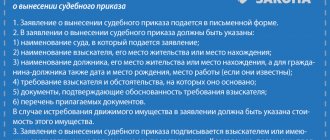Types of executive documents
A writ of execution is a special document that must be issued by a court or other authority when the decision has entered into force. The issuance of this document is necessary in order to initiate enforcement proceedings for debt collection if the payment of the awarded funds by the defendant is not voluntarily executed.
The implementation of enforcement actions based on a court decision or a decision of another body ends the process of collecting a debt that is not paid voluntarily. To carry out this procedure, upon written application of the plaintiff, an executive document is issued, which indicates the amount of financial debt that is subject to collection. The applicant, in turn, submits this document to the bailiff department, who are obliged to take special enforcement measures to collect the debt and facilitate the transfer of funds to the applicant.
Only the claimant or his representative by proxy has the right to submit a written application with a request to issue a writ of execution. This is enshrined in Articles 130 and 428 of the Civil Procedure Code of the Russian Federation.
In some cases there may be exceptions to this rule. For example, if the plaintiff is the state, the court can independently declare the issuance of a document and send it for collection by court order.
According to Article 12 of the Federal Law, which determines the procedure for conducting enforcement proceedings, the following types of enforcement documents include:
- a writ of execution issued by a court (with general jurisdiction or arbitration) on the basis of a court decision rendered by it;
- court order;
- an agreement certified by a notary containing an agreement to pay alimony (copies of agreements certified by a notary);
- a certificate issued by the commission for labor disputes;
- an act issued by the Pension Fund of the Russian Federation and the Social Insurance Fund of the Russian Federation, containing a requirement to collect financial debts from a debtor citizen. Such an act may be issued in relation to a debtor registered as an individual entrepreneur and who has the right to carry out his activities without opening current or other accounts in banks and other credit organizations;
- an act of the control body with attached bank documents on current account numbers, containing a requirement to collect financial debts from a citizen if there are insufficient funds in these accounts to satisfy the legal requirements of the applicant;
- an act of a judicial nature or an act of another body (official) considering cases related to administrative offenses;
- bailiff's order;
- act of another authorized body;
- executive type inscription made by a notary;
- a request from an authority (central) that is appointed in Russia to ensure the fulfillment of financial obligations under international agreements relating to the illegal movement of a child in Russia or the retention of a child in it;
- a writ of execution, which is issued by the competent authority of a foreign state and is subject to execution on Russian territory, in accordance with an international treaty with Russia.
The list of these documents is open. Additions can be made by issuing new federal laws with amendments.
Search for a court order on the official portal of the judicial system of the Russian Federation
How to find a court order by number using computer technology? Nowadays, all court cases are registered and entered into an electronic database, and are also stored in printed form in the archives of the court district. Thus, any person admitted to the information repository, being an interested party, always has the opportunity to obtain information about the document that interests him.
FSSP website
Information can be obtained with the following initial data:
- The number of the court order, which must be entered after clicking on the link on the main page of the “Judges of the Peace” content. On the new page that opens, you must select the electronic link “Case Search”, and then enter 8 digits from the code of a specific document. It should be noted that the serial number of the case at the current site, as a rule, appears in the form of only four numbers, and the second block of numbers is written through a slash, indicating the date of issue of the corresponding resolution.
- In addition, the defendant, without having a number, can always find the information he is interested in by going to the page of the precinct of the magistrate who issued the order. To do this, in the “Judges of the Peace” section, you need to click on the “Find a magistrate’s precinct” button, and then, following the instructions on the screen in the interactive dialog box that opens, enter the location of the precinct and search for available information about a specific authority, including the official website of this department (if it was created).
Important! Unfortunately, no personal data of the parties to the conflict is published on this portal, which makes it impossible to search by the name of any of the parties to the trial. If information about himself is discovered, the debtor is obliged to immediately take all possible measures to close civil proceedings against him by appealing the document or paying off the debt as soon as possible, since ignoring such an order can lead to serious administrative, and in some cases even criminal liability.
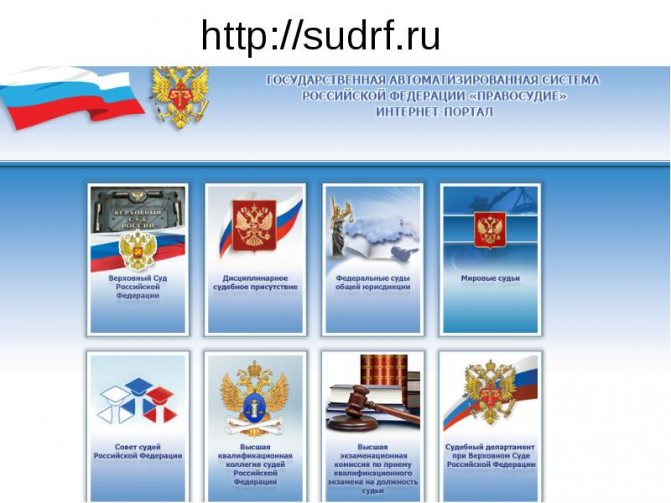
Website of the judicial system of the Russian Federation
Many of our fellow citizens are interested in how to find a court order by the number of the proceedings? As mentioned above, a court order is also the basis for initiating enforcement proceedings. This means that after 10 days allocated to the defendant for appeal procedures, he automatically falls into the hands of the FSSP service, which immediately begins the enforcement procedure.
Thus, after registering a document in electronic databases, information about it becomes available to everyone, and they are published on the official portal of bailiffs, which contains in the body of its content a complete data bank of enforcement proceedings, available via the link. You can check the information you are interested in on this site in the following ways:
- By the name and surname of the defendant against whom the proceedings are being conducted. To do this, you need to go to the main page of the portal, and then, following the prompts, enter the personal data of the debtor into the fields of the search form and select the region of official registration at the place of residence in the drop-down menu provided, and then click “Search”. In the process of detecting matches with the entered information, the system will ask you to go through robot protection, and the applicant will need to enter a 5-digit alphanumeric code.
Based on the search results, if the data was entered correctly and the database contains a dossier on this citizen, he will have access to a list of enforcement proceedings initiated against him throughout the entire period of the database’s existence. It is noteworthy that this portal is not only informational, but also on its pages online payment of debts using a credit card and partner payment systems is available, which allows you to get rid of obligations without leaving your home or office.
- In addition to the standard search by full name, a database is available on the portal that allows you to select the required document by the number of the executive document. In order to use the appropriate form, the applicant needs to click on the “By ID number” link in the top search bar. After this, a new window will open in front of him, in which he will need to enter the document code, select its type from the menu, indicate the name of the magistrate’s precinct and, by analogy with the previous request, determine the region of jurisdiction. After this, the system will provide the same known information as in the first option.

Office of the Judicial District
We invite you to familiarize yourself with the Sample Order for Personnel Order 2020
Important! In the system of enforcement proceedings, the debtor will only have access to information about the total amount of the debt, as well as the grounds for its collection - the number of the enforcement proceedings. In the notes to the current information, as a rule, the number of the document that was the reason for the collection is published. Having rewritten this code, the interested person can already go to the website of the judicial system and, by entering it, receive detailed information about the order itself. However, it will not be possible to obtain complete information on the FSSP portal.
You can also find a court order by number without a PC. If the defendant does not have the technical capabilities and the Internet system is not available to him, he can always take a more complex path and obtain the information he is interested in in the following ways:
- Having received a notice from the court, independently appear at the station where the decision was made and ask the office about the issuance of the document to familiarize yourself with its contents. In such a situation, the citizen’s actions fall under Article 34 of the Code of Civil Procedure of the Russian Federation, which speaks of his legal right to familiarize himself with the case materials if he is a participant in the process. Thus, to initiate the procedure for issuing a document, it is necessary to draw up and submit to authorized employees an application to remove the papers of interest from the archive, and the court does not have the right to refuse a citizen this request. Thus, employees endorse the paper from the judge, after which they give the applicant the right to look at the information he is interested in in a special room under the supervision of a civil servant, and also make copies of it.
- After initiating enforcement proceedings, you can also attend an appointment with the bailiff and receive the copies of the papers you are interested in. If the defendant is sure that a false procedural action was committed against him, he has the right to write an application to reverse the enforcement proceedings (in accordance with Article 443 of the Civil Code of the Russian Federation). This petition entails a review of the case, and in some cases, if a forgery is detected, the cancellation of the court order and the subsequent rehabilitation of the rights of the suspect, from whom all obligations have been removed.
- In the case where a citizen is not very concerned about the expiration of the period for appealing a document, and he is only interested in information about the current order, he can send a postal request notifying him of the provision of the case materials, which again falls under Article 34 of the Code of Civil Procedure of the Russian Federation. In the case of bailiffs, bailiffs, receiving orders from the magistrate's court, as a rule, notify citizens with subpoenas and demands to appear at the relevant department of the FSSP to begin enforcement proceedings against the debtor and reach other agreements on debt cancellation through reconciliation of the parties after organizing certain compromises.
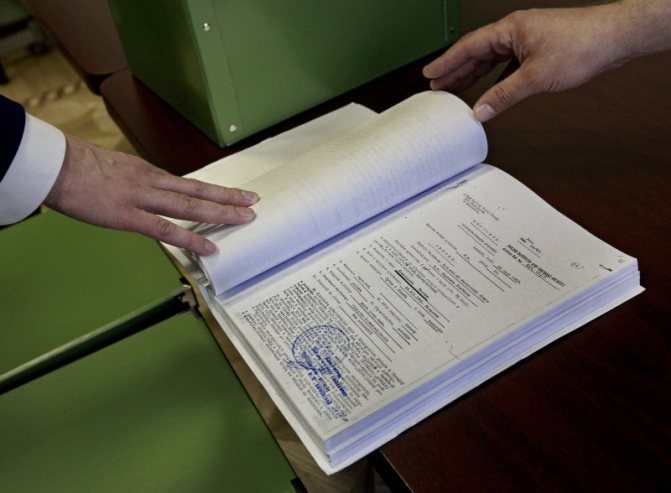
Familiarization with the order
Important! Attempts to find out information of interest by telephone number, as a rule, do not give the desired effect, so it is better to carry out all actions exclusively through a personal visit to a government agency.
In conclusion, it is worth saying that not a single resident of our country is insured against a civil lawsuit, and cases are sometimes considered so secretly and quickly that the defendant does not even have time to take any measures to ensure his own legal protection. It is for this purpose that at least once a month each Internet user must carry out a short procedure - make electronic requests to the above departments regarding his person.
However, when both parties are in agreement with each other regarding who owes whom and how much - that is, no controversial issues arise, the situation can be resolved by a magistrate (legal entities need to go to arbitration).
Writ proceedings are a simplified form of procedural resolution of civil cases. We will figure out how to find a court order by number, and also answer a number of other questions directly related to this topic.
Important! From June 1, 2020, writ proceedings are a mandatory process and not an option for debt repayment. Provided that there are all legal grounds for considering the case within the framework of this proceeding.
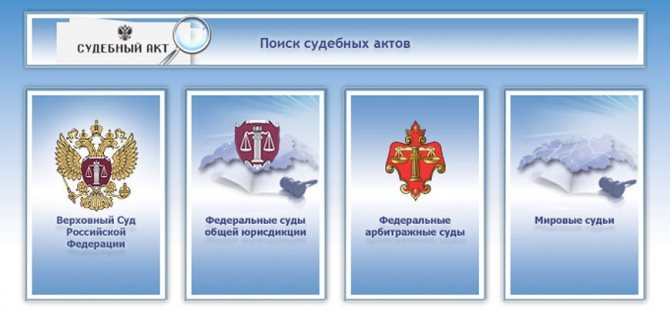
Often the debtor receives a court order untimely. Although it is in his interests to receive a court order for payment on time and not miss deadlines. This way, you will be able to avoid additional expenses in the form of a fine and appeal the decision if you can document the case.
To see the decision made by a magistrate or arbitration, it is not necessary to stand in line at the court office. Just go to the “Justice” service.
There are two search paths:
- According to the court area where the decision was made.
- According to the number of the case that was in production.
Executive documents
Let's analyze the search for an order by number:
- On the main page of the “Justice” service, select the “Judges of the Peace” section and go to the section by clicking on it.
- Next, click on the “Case Search” option.
- Going to a new tab, fill in the empty lines - enter or select from the window the desired subject of the Federation, the name of the judicial institution, the number of the case that interests you.
- Having filled in the information required for the search, click on the “Find” function.
Important! You should know that the case number consists of 8 digits. The last 4 digits, which are located after the inclined vertical line, are the year of the decision.
As part of the answer to the question of whether it is possible to find the document of interest by the last name of the debtor, it should be noted that this is impossible. This procedure can be carried out on the official resource of the bailiffs' executive service.
- enter your full name.
- region of actual residence,
- enter the captcha.
Court order as an executive document
In order for the execution of a court order for debt collection to be carried out quickly and efficiently, the document must contain complete and reliable information about the collector and the debtor. In addition, other data that is important to the case under consideration must be indicated there. According to Article 13 of the Federal Law, which determines the procedure for conducting enforcement proceedings, the document must contain the following data:
1. Address and full name of the judicial or other body that issued the document, as well as the full name of the official in charge of the case.
2. The name and number of the case (materials) on the basis of which the court order was issued, the collection on which will be carried out.
3. The date of the court decision or the decision of another body (a specific person).
4. The date on which the decision comes into force, or an indication that the decision is subject to immediate execution.
5. Information about the creditor and debtor:
- if the parties are citizens: first name, last name, patronymic, place of residence and location of both parties; place and date of birth, place of employment (if information is available) of the debtor only, place and date of registration as an individual entrepreneur, his individual tax number (if the debtor is an individual entrepreneur);
- if the parties are legal entities: full name, legal and actual addresses, date of registration with a government agency, individual tax number;
- if one of the parties is the Russian Federation or a foreign state: the full name and location of the body that is authorized to exercise rights and fulfill obligations as a party to enforcement proceedings.
6. The operative (final) part of a court decision or act of another body, which contains a requirement to impose on the defendant the obligation to transfer to the recoverer a certain amount of money, other property or to perform specific actions in favor of the plaintiff (to refrain from performing specific actions).
7. Date when the writ of execution was issued.
If one of the mandatory points is missing from the court order, execution on it will not be carried out, since the non-compliance of the document with legislative norms deprives it of enforcement power. If you submit such a document to the bailiff department, a refusal to initiate enforcement proceedings will be issued and it will be returned to the applicant. Therefore, before sending a court order to collect a debt for execution, it is necessary to check its contents for errors, typos or omissions.
Court order for debt collection where to view
Many people consider debt collection through a judicial body to be a lawsuit-like process, exhausting visits to numerous court hearings, and other problems.
A court order to collect a debt (regardless of its type), issued by the courts in specific cases, is immediately considered both a court decision and an executive-type document. Its main meaning is revealed in Article 121 of the Code of Civil Procedure of the Russian Federation (as well as the maximum amount of recovery - 500,000 rubles).
The basis for its registration is the claim of the applicant for the collection of funds or things in the presence of the following circumstances:
- If the claims arise from a transaction that was previously certified by a notary.
- If the claims arise from a contract drawn up in simple and written form.
- If the claims arose because the notary filed a protest against the bill for non-payment, if there are other reasons.
- If the claims affect alimony payments - with the exception of the following situations: if at the same time paternity (and sometimes maternity) is established or disputed, or if there are interested persons.
- Employees can file claims if they were not paid their due wages, vacation pay, or compensation payments due to leaving the workplace.
- Claims regarding the collection of due, but not credited, compensation payments for the manager’s failure to comply with the time frame for paying employees wages and other various payments.
Such a process is a simpler version of a trial based on orders that are entirely proven by special documentation (if the claimant and the defendant do not have serious conflicts with each other).
As a rule, justices of the peace study such applications (and issue court orders). The nuance of the procedure is as follows: the judge announces the decision within 5 days after the corresponding application is received. The parties are not summoned to court and their testimony is not heard.
If the judge refuses to issue a court order, the defendant may not receive a response at all. If the application is granted, the debtor will receive a certified copy of the document we are considering.
The procedure for issuing such a document is a unique method of legal proceedings. In this case, there is no and cannot be any appeal control from a higher court.
To view a court order, use the following methods:
- Open a special section on the FSSP website.
- Contact the bailiff with a request to issue you a copy of the document.
- Contact the clerk of the magistrate who made the decision.
But, in my practice as a lawyer, there have also been cases when court orders were issued completely without any grounds, either on the basis of forged documents from collectors, or in relation to citizens who had already voluntarily paid their debt or part of it. In such situations, it is simply necessary to appeal an illegal document.
Refusal of individuals or legal entities to repay debt is a common phenomenon. You take other people's money and give yours. This does not speed up the calculation process. To collect a debt, it is common to file a lawsuit in court.
However, when both parties are in agreement with each other regarding who owes whom and how much - that is, no controversial issues arise, the situation can be resolved by a magistrate (legal entities need to go to arbitration). Dear readers! Important! Problems related to collection are classified as complex cases.
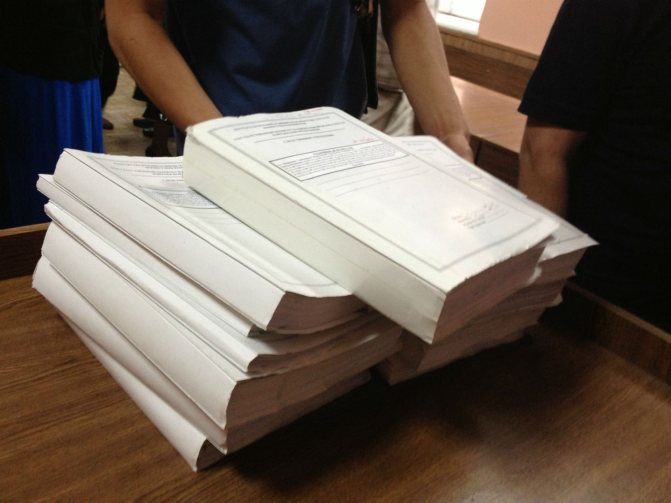
We will figure out how to find a court order by number, and also answer a number of other questions directly related to this topic.
It is necessary to take into account and know that the date of sending your objection by mail will not be the date it was received by the court office, but the date the postal worker noted that your letter was accepted, even if this letter arrives at the court a month after it was sent. Your job is to send a letter of objection within 10 days!
- The objection does not have to be motivated by anything, it is not necessary to refer to the norms of the law, there is no need to prove anything regarding the debt, its size, etc. It is enough just to write your request to cancel the issued document.
If the plaintiff’s application is refused, the court must make an appropriate decision within 3 days after the application. The state fee paid by the lender is not refunded. We also read how to correct your credit history if it is damaged by non-payments and late payments? You shouldn’t count on this option - the bank has competent lawyers, and the document will almost certainly be drawn up correctly.
- Where can I see the court order?
- Where can I view the court order?
- How to find out a court decision in the Russian Federation by last name in 2020
- How to cancel a court order?
- Where can I see the court order?
- Cancellation of a court order
- Why cancel the order?
- Court order: how to find it by number and surname Drawing up an objection
- Sample objection to a court order 2020
- Canceled, what next?
Where can I see the court order? A court order is a document issued by a judge based on the evidence provided on the one hand. At the same time, a court hearing is not formed and the parties are not summoned to consider the case. Necessary documentation Despite the fact that this procedure is considered a simplified legal procedure, special attention must be paid to the submission of papers. The consideration of the case begins with the claimant filing an application, which, according to Article 124 of the Code of Civil Procedure of the Russian Federation, must contain the following:
- Name of the judicial institution.
- Full name of the claimant and the defendant, residential or registration addresses.
- Papers that actually confirm the debt and serve as justification for the claimant’s demands.
- Detailed requirements of the claimant and supporting facts.
- Description of the attachment.
In this case, it is necessary to provide irrefutable evidence of the reality of the debt. After reviewing the submitted documents (no more than 5 days are allotted for this), a decision is made. The presence of the parties when studying the circumstances of the case is not required. This order is mandatory for execution by any debtor - be it an individual or a legal entity.
There is liability for failure to comply with such a resolution. How to find a court order? Situations often arise when a person is aware of the decision regarding his order, but for some reason does not receive it. The debtor is interested in the timely execution of this order (so as not to receive an additional fine) or appealing it (if there is evidence of his innocence). Naturally, with any of these options, there is an understandable need to contemplate the document with your own eyes.
However, during the consideration of the application, there is no opportunity to provide additional arguments and present evidence, because the consideration of the application for the issuance of a court order occurs without the participation of the debtor. In this regard, the legislation provides for a special procedure for appealing court orders.
The judge cancels the order if the debtor raises objections within the time limits established by law. Even if the stated objections are not motivated, and the position is not supported by relevant legal norms, the court order must be canceled. At the same time, the claimant has the right to subsequently file a claim in court for the same requirements.
In order to exercise the right to appeal a court order, the debtor is obliged to send his objections to the court within ten days from the date of receipt of the said document. Objections must be sent in writing, always in two copies.
The presence of the defendant and the plaintiff is not necessary to reach a verdict. The collection is carried out after the issuance of a court order, which is issued five days after filing the application.
Article 122 of the Code of Civil Procedure of the Russian Federation specifies the requirements in accordance with which this document is issued - these are:
- If the debt arose under a receipt that was previously certified by a notary;
- If the notarial protest of the bill is for non-acceptance, non-payment, and non-dating of acceptance;
- Debt in child support payments for minor children;
- Wage arrears that were accrued but not paid;
- When demanding from the authorized bodies the return of expenses that arose at the time of searching for the defendant.
- If the debt was formed by receipt;
When a court order is issued, the applicant
To receive an order there must be substantial grounds, which include:
- confirmed transactions that are documented in writing; there is notarization; the claim concerns debts to taxes or creditors; if the claim is aimed at compensation for accrued but unpaid wages; to return alimony debt.
We suggest you familiarize yourself with the order in which contributions are transferred within the framework of the state co-financing program.
The solution can be used if the Ministry of Internal Affairs is trying to receive compensation for the costs associated with searching for the debtor.
This often happens if the debt is large, and the debtor himself has disappeared, although he can compensate, if not all, then most of it. A decision on a case is made within 5 days, and having made it, the authorities have three days to send copies of documents to interested parties. The order is issued on a special form.
Its form is established by the state. But there are requirements not only for the design, but also for the content of the paper.
Basic requirements for a court order
In order for the applicant to be protected from the return of the court order, and the debtor from the violation of his rights, the court order for debt collection must meet the following requirements:
- An executive document must be drawn up in accordance with all regulatory requirements established by the thirteenth article of the Federal Law in question.
- A document of an enforcement nature must be presented within the time limit established for the presentation of a court order (according to Article 21 of the Law).
- An executive document is issued solely on the basis of a court decision or a decision of another body that has entered into legal force. A note about this is made on the court order for execution.
These three important rules will allow the applicant to reduce the time frame for carrying out enforcement actions. For the debtor, these requirements, on the contrary, make it possible to appeal the issuance of this document (if the deadlines for filing an appeal are met) and slow down the progress of enforcement proceedings. In some cases, debtors even seek its cancellation.
Types of legal proceedings for which a court order is issued
Regarding the execution of a court order, it must be said that it can be issued only for three reasons:
- failure to pay child support obligations;
- tax debts or debts on fees;
- outstanding loans.
The issuance of a writ of execution of this type is due to the need for the speedy collection of specific types of debts.
The magistrate issues a document based on written information provided by the plaintiff confirming the defendant’s debt and the applicant’s right to collect this debt.
The procedure for executing a court order is the same as with other types of writs of execution. For failure to comply with the requirements contained in the document, the legislation establishes certain types of liability. Apart from the fulfillment of monetary obligations to the applicant, there cannot be any other requirements in the order.
Limitation period for a writ of execution
Article 16 of the Federal Law in question determines the moment when the statute of limitations for a court order to collect a debt expires. If we are talking about calculating a period calculated in years, its end is considered to be the corresponding date of the same month in which the writ of execution was submitted.
When calculating the deadline for executing a court order for debt collection in months, its end date is considered to be the same day in the last month of collection. If the period is calculated in days, the end day is before the end of the day of this day (or before the end of working hours of the corresponding bailiff department, where the writ of execution is submitted).
The legislation defines two types of limitation periods: general and special. The general limitation period is three years from the date of issue of the court order. Special – established by the court (it can determine a shortened period of execution of a court order or set a specific date).
In some cases, the court may mark that the document is subject to immediate execution. Such situations include the issuance of an order for the payment of alimony.
By law, courts are required to post court orders on the Internet.
Legislators obliged each court to provide citizens and legal entities with access to information about the work of courts, including on the Internet. In accordance with Federal Law No. 262 “No. On ensuring access to information about the activities of courts of the Russian Federation”, Article 15, the text of the document must appear on the website.
You can use the website of the court that created this document if you know the name of the debtor or the number of this order. In order to find a court order, you must select the “Court Proceedings” section on the website, then click “Search for information on cases,” and indicate known information in the “Last Name” or “Case Number” field.
It is easier to search for a document by number, since cases with namesakes will be eliminated. The card that opens should reflect information about the progress of the case. If the result of the meeting was the issuance of a court order, but its text is missing, then you can find information about it in other documents that are present on the site.
Publication of information by arbitration courts occurs within 24 hours from the moment the order is issued. But courts of general jurisdiction do not show such efficiency; the same situation occurs with court orders. The Code of Civil Procedure of the Russian Federation does not determine specific deadlines for the publication of information, so there are no sanctions for this.
That is why it is not always possible to find a court order and find out the necessary information about debt collection. The fact is that the courts work with a huge number of these cases, so the employees of this instance do not always have time to add information to the electronic card. But if you can’t find the required document on the court’s website, you can use a number of other resources.
We suggest you read: Is it possible to return a prepayment for a car and how to do it
Stages of the process of executing a court order
The entire process of implementing the requirements specified in the executive document comes down to six stages:
- Making a decision by the court.
- Waiting to receive the defendant's objections.
- Transfer of the writ of execution for collection to the department of bailiffs according to the place of registration of the debtor.
- Issuance of a resolution to initiate enforcement proceedings.
- Assessing the debtor’s financial situation through a visit to the defendant’s place of residence and checking his bank accounts.
- Forcible collection of funds.
If the debtor voluntarily repays the debt in full within the five days established by law, the last two points are not fulfilled.
Key points
A court order from a magistrate is necessary for the creditor to repay the debt as quickly as possible. The document is used as conclusive evidence of the party who filed the claim. The judge issues an order against both parties.
A court order from a magistrate is considered an executive document that is sent to a specific object or subject. Five days after its release, an additional opportunity appears - viewing the decision online.
An order is an official document that includes standard items:
- Registration number.
- The name of the government agency that issued it.
- Full information about the judge.
- Full name of the debtor from whom collection will be made in the future.
- If we are talking about alimony, then detailed information about the children is additionally indicated.
- The name of the regulatory document on the basis of which the decision was made.
- The total amount owed on a specific obligation.
- Amount of tax due.
- Bank account for transferring the amount.
- The period during which the debt accumulated.
The transfer of orders to both parties must be carried out within three days. Additionally, one version of the document remains in the office and with the lawyer who represented the interests of the parties. The debtor is given ten days to appeal the decision.
The order will have to be canceled if the debtor expresses his disagreement. If it is necessary to collect alimony or utility debts, then the application does not have to indicate the reason for its preparation.
Example of a court order
Appeal against a court order
The stage of filing an appeal, as in the case of a decision by a district or other court, is absent in writ proceedings. You can challenge the judge's decision by filing reasoned objections on the part of the defendant.
The period for accepting objections is ten days. If the defendant managed to present his arguments within this period, the judge reverses his decision and clarifies that the parties have the right to settle the dispute through the district court. The court sends its decision to cancel the court order to the parties within a period of no more than three days.
If the debtor filed his objections after the deadline, he is obliged to provide evidence of the missed deadline. If evidence is not provided or is unreliable, the order remains in force.
Deadline for fulfilling the requirements in the executive document
If everything is clear about the validity period of the court order for debt collection, the execution date remains unknown. If no objections were received from the defendant, and the plaintiff immediately handed over the document for execution to the bailiffs, even if voluntary compensation of the debt is refused, the entire process may take no more than a few months.
If, when checking the debtor’s financial condition, it was not possible to establish the presence of property that can be foreclosed on, and the check of bank accounts did not produce positive results, the process may be delayed. In some cases, such debtors take informal jobs and receive wages in cash.
If income, property and place of employment are actively concealed, the collection process can drag on for several years. If the bailiffs closed the enforcement proceedings on this basis and returned the writ of execution to the applicant, the plaintiff has the right to re-file it.
How the search is carried out
Very often, the court order arrives to the debtor late, although it is in his interests to receive this document as early as possible and not miss the payment deadline. If the deadline is not missed, the debtor can avoid additional expenses, such as fines and appealing the decision, if it is possible to prove his case with documents.
We invite you to familiarize yourself with the conditions and procedure for dismissal for absenteeism, registration and sample order
In order to view the court order for collection, which was issued by the magistrate court and the arbitration court, it is not necessary to contact the court office and waste time in line. To do this, you can visit the portal of the state automated system of the Russian Federation “Justice”.

In this case, you can use one of two search methods:
- According to the section of the court that issued this order;
- By the number of the case that is in production.
You should look in detail at how to find a court order. You can find it by number using the following instructions:
- On the main page of the “Justice” portal, select the “Judges of the Peace” section and then click on it;
- Then select the “Case Search” option;
- After switching to a new tab, you should fill in the empty fields, in this case you should enter or select from the proposed list the desired subject of the Russian Federation, the name of the court and the number of the case that needs to be found;
- After the search information is filled in, click the “Find” button.
It is worth remembering that the case number has only eight digits. The last four digits, the location of which after the inclined vertical line, is the year the order was issued.
It is also worth noting that it is impossible to find a court order by last name; this procedure can only be carried out on the official website of the bailiffs' executive service.
But even here there are several nuances. You can find the necessary information on the bailiffs website only in one case, if 10 days have passed since the decision was made. And also, if the amount of the collected debt has not been repaid, and there is no appeal. If these conditions are met, then the data about the debtor will be transferred to the bailiffs and published in the database.
To search, use the following algorithm:
- Enter your full name;
- Indicate the region of actual residence;
- Enter the captcha.
In addition to information about individuals, you can check information about organizations on the site.
Also, if the defendant does not have an order number, he can find the necessary information by visiting the page of the magistrate who created the order. To do this, you need to go to the “Judges of the Peace” section. Then click on the “Find Magistrate Precinct” link and continue to follow the instructions in the interactive window that will open.
It will not be possible to find personal information about the parties to the conflict on the site, so searching by full name becomes impossible. But if the debtor saw personal information about himself on the site, then he must take all measures to close the civil proceedings by appealing the document or by quickly repaying the debt. After all, ignoring this order entails administrative liability, and in some cases, criminal liability.
Actions to comply with the requirements of a court order
After the judge has received an application for an order, checked the form of the application and the sufficiency of the evidence presented, he makes a decision to issue an order or to refuse to issue it.
Since writ proceedings are carried out in the absence of the parties to the proceedings, the unreliability or insufficiency of the evidence presented may lead to a decision to refuse to issue an order.
If the order is nevertheless issued and the defendant has not filed an objection to it, enforcement proceedings are opened. There are two ways to implement a court decision: voluntary and compulsory.
The voluntary method provides for the debt to be repaid by the defendant under a court order. The payment period is set at five days. The defendant can repay the debt by transferring funds to the account of the creditor organization, wife receiving alimony, etc. The compulsory method involves contacting the defendant at his place of residence and place of registration in order to identify and seize property that can be seized.
All seized items must be handed over to the applicant as part of the payment. If the applicant does not need them, the bailiffs sell them at auction, and the proceeds are transferred to the plaintiff’s account.
If the amount of funds received for the sold item is higher than the amount of debt, the plaintiff returns the difference to the defendant in person or by transferring money to a bank account.
State duty amount
The one hundred and twenty-third article of the Civil Procedure Code establishes that the filing of an application for the issuance of an order by a justice of the peace of the judicial district is carried out only upon payment of the state fee, the amount of which is established by Article 333.19 of the Tax Code.
Tax regulations stipulate that for the issuance of a court order, the plaintiff must pay fifty percent of the amount that he would have paid when filing the corresponding application with the district court.
For socially unprotected categories of people (pensioners, low-income people, etc.), the legislation does not provide any benefits in relation to the amount of state duty. All citizens pay the state fee established by law for the process conducted by a magistrate.
If the application for a court order was returned due to insufficient evidence, the amount of the paid fee can be returned (second subparagraph of the first paragraph of Article 333.40 of the Tax Code of Russia). If the decision was canceled due to the defendant filing objections to the order, this fee is not subject to refund or offset.
A court order is the fastest way to make a judgment. It should be understood that if the defendant does not agree with the decision made, the document will lose its force, and the state fee paid by the plaintiff will not be returned. Therefore, it is important to draw up all the documents correctly and decide whether it is really worth filing such an application or whether the matter can be resolved in another legal way.


